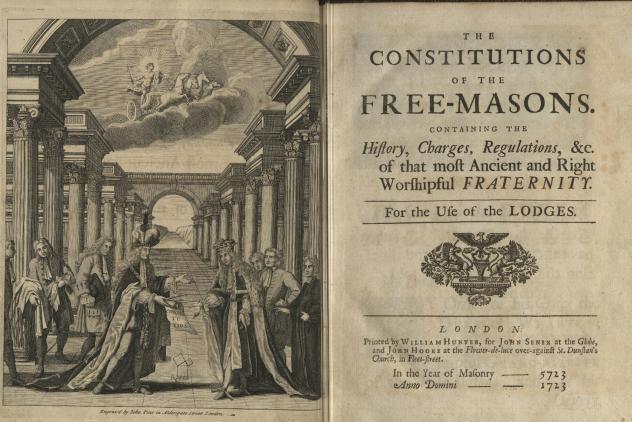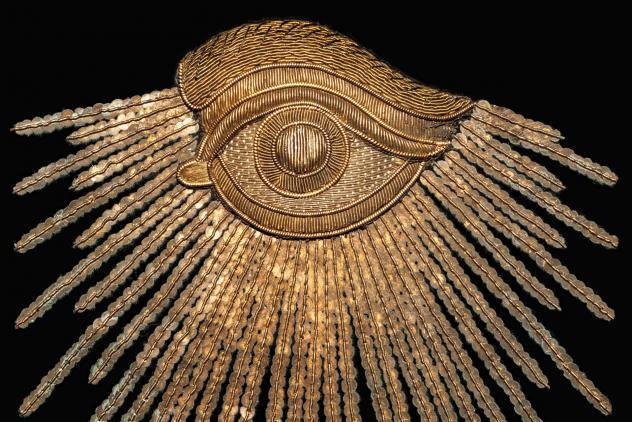The Hall Stone story
How the crest of Freemasons' Hall came to beSad news from the front
At the end of the First World War the United Grand Lodge of England had just celebrated its 200th anniversary. Unfortunately this coincided with sad news of almost 3,000 members lost to the war. The names and lodges of these men had been gathered in a Roll of Honour throughout the period, with a final version not being completed until 1921.

A special request
A special Grand Lodge meeting was held at the Royal Albert Hall in July 1919 to celebrate the end of the Great War and the arrival of peace. The Grand Master at this time was Arthur, Duke of Connaught, and an address was delivered on his behalf requesting that a new hall be built. It would stand as a memorial to the freemasons who died in the war.

The first jewel
Freemasons call their special badges ‘jewels’ and a new commemorative jewel was commissioned for those who had attended the special Grand Lodge meeting in July. Known as the Peace Jewel it was the first of the jewels that would come to be associated with the new hall.

The winning design
In January 1920 a letter was sent to all lodges from the Grand Master informing them of the Masonic Million Memorial Fund as it was now officially called. Freemasons who contributed to the fund would receive a jewel. Chosen through a competition, with 75 guineas as a prize, the winning design was by Cyril Saunders Spackman. It features a cross representing sacrifice and an angel of peace holding a model temple surrounded by a garland.

Hall Stone appears
Four types of Hall Stone jewel were made. A freemason who contributed at least 10 guineas received a silver jewel, more than 100 guineas, a gold jewel was given. Lodges that contributed an average of 10 guineas per member had their names recorded in the new building and be awarded a gold jewel. If all lodges in a Province or District donated an average of 500 guineas or more they would get a large colour enamelled jewel.

Fifth element
At a later stage a fifth jewel was introduced. It was known as a Special Collector’s jewel for those members who raised a list of contributions of at least 250 guineas. The design of this jewel differs from Spackman’s established Hall Stone motif, though it still shows an angel of peace and a model temple. Another variation appears later.

Not a small task
A competition was held to determine the design of the new building. In 1926 it was announced that architects Ashley and Newman had won with their design. They had been in partnership since 1907, with a range of successful buildings to their name already. These men would be the ones tasked with delivering the new hall to their fellow freemasons.

An olympic lunch
Meanwhile the appeal continued. One notable event was a sit-down five course meal held at the Kensington Olympia in August 1925. The Grand Master was joined by 7,000 freemasons in what is still the largest catered meal ever served in Europe. A special jewel was issued to those who took part in this fundraiser. Like the Special Collector's jewel it was a departure from the Hall Stone though it retained certain elements.

Foundations are laid
Construction on the new hall began in 1927. There was a foundation stone laying ceremony in July, at the Royal Albert Hall. 8,000 freemasons witnessed a block being lowered simultaneously with the real one at the actual site. The Grand Master ceremoniously tapped this real stone using a maul from the Lodge of Antiquity No.2, said to have been used by Sir Christopher Wren to lay the foundation stone of St. Paul’s Cathedral.

A building rises
Soon the building began to rise above the surrounding streets. It was essentially a truncated New York skyscraper, steel girder frame construction and fitted with all the modern amenities: air conditioning, warm air heating, lifts, electric clocks and even a centralised vacuum cleaner system that fed down to a pump in the basement. All the fittings were specially designed to fit the theme of the building.

Exceeding expectations
The new hall, dubbed the Masonic Peace Memorial Building was completed in 1933. The total cost was around £1.4million. There were around 50,000 individual Hall Stone and Special Collector’s jewels issued and 1,321 lodges had become Hall Stone Lodges, their names inscribed on the walls of the Temple Vestibules. Three Provincial/District Hall Stone jewels were issued, to Buckinghamshire, Burma and Japan. The former is still worn in Buckinghamshire, the latter two were lost over time. Perhaps one day they will be rediscovered.

The final Hall Stone design
The Masonic Million Memorial Fund was finally closed in 1938. The following year saw the outbreak of the Second World War and the building was renamed Freemasons’ Hall, the name it bears today. You can see the Hall Stone design incorporated in the building, including the stained glass Memorial Window above the Roll of Honour outside the Grand Temple. In this version of Spackman's design, the angel of peace holds a model of the finished building.



